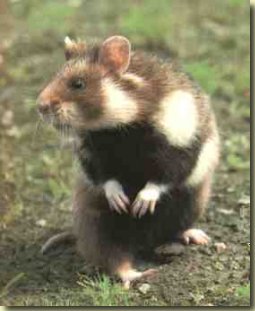
{ Home | Care Guide }

The story of hamsters has been embellished and idealized over the years... here is what probably happened...
In 1839, British zoologist George Waterhouse reportedly found an elderly female hamster in Syria, naming it "Cricetus auratus," the Golden Hamster. The hamster's fur was on display at the British Museum.
Around 1930, zoologist and Professor at the University of Jerusalem Aharoni found a mother and litter of hamsters in the Syrian desert. By the time he got back to his lab, most had died or escaped. The remaining hamsters were given to the Hebrew University in Jerusalem, where they were successfully bred as Golden Hamsters. They were a bit bigger than the ones Waterhouse found, so they were named "Mesocricetus auratus", although they were probably the same species.
The hamsters were shipped to labs all around the world. They arrived in the United Kingdom in 1931, and in 1938 reached the United States. Just about all Golden Hamsters are descended from the original litter found in Syria except for a few that were brought into the United States by travellers who found them in the desert. A separate stock of hamsters was imported into the US in 1971, but it isn't known if any of today's North American pets are descended from them.
The Dwarf Campbells Russian, Winter White Russian and
Chinese were all introduced to the pet market in the United
Kingdom in the 1970s, and the Roborovski hamster came from
Holland into the UK in 1990.

Hamsters are now used for scientific research. Because hamsters are so disease-free and breed so rapidly (they can have a new litter every month!) and because they are so friendly and easy to handle, they are a popular choice among scientists. They are often used for cardio-vascular research, as their cardio-vascular system is remarkably similar to that of the human.
In the wild, hamsters are a nuisance to farmers. Hamsters
have been known to hide in excess of 60 pounds of grain to feed
them through the winter.
For more hamster history, look under introduction in our hamster care index.
Hamsters Today Because of their cute appearance, hamsters have been mistaken for gentle, social, loving creatures no matter which hamster it is. This is but a stereotype, and a false one at that. Sure, hamsters can be gentle and loving creatures if they have the right care and treatment. But by nature they are not social with other hamsters (other animals, yes, but not others of its own kind). Because of their inbreeding, todays pet hamsters have a tendancy to be short-tempered and hostile. Expessially when kept in cages with more than 1 other hamster at pet stores and such. Please stop (and help me to stop people from) saying that hamsters are aggressive, mean, and bite. Not only is this a generilization (or stereotype, like saying that all people are good if they are white and are religious), but a cruel one. Obviously these people have never taken time off of their busy life to see from a hamsters point of veiw.

Have a comment? Click here to send it to us.